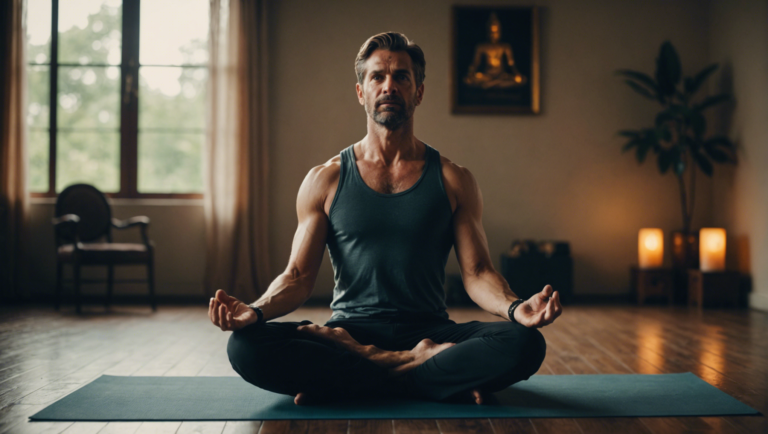Unveiling The Potential Dangers: Why Yoga Can Be Bad For You
Unraveling the Hidden Risks: The Dark Side of Yoga Practice
Yoga: A Path to Wellness or a Road to Injury?
From ancient times, yoga has been hailed for its unparalleled benefits in enhancing physical flexibility, mental clarity, and emotional tranquility. Promoted as a holistic approach to wellness, it has gained a passionate following across the globe. Yet, beneath the serene surface of this seemingly benign practice, there exists a hidden dimension fraught with potential risks that warrant a closer examination.
Understanding the Shadows Beneath the Stretches
While practitioners and enthusiasts often tout yoga as a panacea for a wide array of ailments, the reality is that yoga, like any physical activity, carries its own set of risks. The allure of achieving the perfect pose or pushing the body beyond its natural limits can lead to strain, sprains, and even serious injury.
Musculoskeletal injuries are among the most common issues faced by yoga practitioners. The pursuit of flexibility, especially without adequate preparation or understanding of one’s own physical limits, can lead to overstretching and damage to the ligaments and tendons. Similarly, repetitive stress injuries can occur from performing the same poses frequently without adequate rest.
The Paradox of Pain and Healing
Ironically, while yoga is sought for pain relief, it can sometimes exacerbate underlying conditions. Individuals with pre-existing conditions such as herniated discs, arthritis, or osteoporosis may find that certain poses aggravate their symptoms. This paradox highlights the critical importance of understanding one’s body and consulting with healthcare professionals before undertaking or modifying a yoga practice.
Psychological Strains: The Overlooked Aspect
Beyond the physical, the psychological impacts of yoga are seldom discussed. The quest for perfection or comparison with peers can foster a sense of inadequacy, stress, and anxiety, counteracting the very benefits yoga aims to provide. This mental strain, coupled with the competitive atmosphere that can pervade some yoga classes, underscores the need for a supportive and nonjudgmental yoga environment.
Navigating the Risks: Strategies for a Safe Practice
To mitigate these risks, several strategies can be employed. Firstly, beginners and those with pre-existing conditions should consider seeking the guidance of experienced, certified yoga instructors who can tailor practices to individual needs and limitations. Listening to one’s body and acknowledging its limits is paramount in avoiding injury.
Engaging in a balanced yoga practice that incorporates a variety of poses and focuses on gradual progression rather than immediate results can also minimize the risk of physical strain. Additionally, incorporating rest days and complementary physical activities can help prevent overuse injuries.
Emphasizing Safety and Awareness in Yoga Communities
Yoga instructors and studios play a pivotal role in fostering safe practices. By emphasizing the importance of individualized approaches and the inherent value in each practitioner’s journey, the yoga community can help mitigate the competitive undertones that lead to injury.
Education on the potential risks associated with yoga, coupled with strategies to avoid them, should be an integral part of yoga instruction. Instructors should be equipped not only with a deep understanding of anatomy and physiology but also with the ability to recognize when a pose may do more harm than good for a student.
Toward a Holistic and Inclusive Yoga Practice
In embracing a more informed and cautious approach to yoga, practitioners can enjoy the myriad benefits it offers without falling prey to its potential pitfalls. A holistic practice that respects the body’s limits, nurtures the mind, and fosters a supportive community can transform yoga from a practice shadowed by risks to a truly transformative journey.
By acknowledging and addressing the risks inherent in yoga practice, the yoga community can ensure that yoga remains a safe, accessible, and enriching path to wellness for everyone. The goal is not to instill fear but to promote a well-informed, balanced approach that honors the ancient tradition of yoga while safeguarding the well-being of its modern-day practitioners.
The Physiology Behind Yoga Injuries: Understanding the Science
Yoga, a practice steeped in ancient tradition, is renowned for its benefits on mental, physical, and spiritual health. However, as yoga’s popularity soars, there’s an expanding conversation around the potential for injuries and the science behind them. Understanding the physiology behind yoga injuries is crucial for practitioners and instructors alike to prevent harm and promote a safe practice.
The Anatomy of Common Yoga Injuries
Yoga involves a series of postures (asanas), breathing techniques (pranayama), and meditation practices. While it aims to improve flexibility, strength, and mental well-being, without proper technique and body awareness, yoga can lead to injuries. Common injuries include muscle strains, joint sprains, and more serious conditions like nerve damage or disk herniation.
Muscle strains are prevalent among beginners who might overestimate their flexibility and strength. These strains often occur in the hamstrings, shoulders, and back. Joint sprains, on the other hand, are typically seen in wrists, knees, and ankles, primarily resulting from improper alignment and the repetitive nature of some asanas.
Understanding the Science of Stretching
Stretching, a fundamental aspect of yoga, aims to increase muscle and joint flexibility. However, the science of stretching reveals a delicate balance between flexibility and stability. Overstretching can lead to a decrease in the muscle’s ability to stabilize the joints, increasing the risk of joint injuries.
The mechanism behind stretching involves altering the muscle’s length-tension relationship. Muscles have an optimal length at which they can generate maximum force. Deviating from this length, either through overstretching or lack of flexibility, can diminish muscle performance and predispose to injuries.
The Role of Proprioception in Preventing Injuries
Proprioception, or the body’s ability to sense its position in space, plays a crucial role in executing yoga poses safely. A lack of proprioceptive awareness can lead to misalignments and compensatory movements, placing excessive stress on certain muscles and joints.
Improving proprioception through mindful practice and focusing on alignment can significantly reduce the risk of injuries. It’s about moving with intention and listening to the body’s signals, avoiding pushing beyond its limits.
The Importance of Individualized Practice
One size does not fit all in yoga. Individual anatomical differences mean that a pose beneficial for one person might be harmful to another. Factors such as body type, existing injuries, and flexibility levels should guide the practice.
A customized yoga regimen that considers individual needs and limitations can foster a safer environment. Engaging in variations or modifications of poses ensures that the practice enhances well-being without risking harm.
Encouraging Safe Practice
For yoga practitioners, recognizing the fine line between challenge and harm is vital. Gradually increasing the difficulty and duration of practice allows the body to adapt without strain. Additionally, seeking guidance from experienced instructors can provide insights into proper form and posture alignment, reducing the risk of injuries.
Listening to the body and acknowledging its limits is also fundamental. The pursuit of advanced poses should not come at the expense of well-being. rest and recovery days into the yoga routine can help prevent overuse injuries, ensuring a sustainable practice.
While yoga offers numerous benefits, it carries the risk of injuries if not practiced with awareness and respect for the body’s limitations. Understanding the physiology behind these injuries—be it from the perspective of stretching, proprioceptive awareness, or individual anatomical differences—can equip practitioners with the knowledge to navigate their practice safely. By fostering an environment that prioritizes safety, alignment, and individual needs, the yoga community can continue to harness the profound benefits of this ancient practice, while minimizing the potential for harm.
Yoga’s Contradiction: When Spiritual Practice Leads to Physical Harm
Yoga, a revered spiritual practice with a history spanning thousands of years, has burgeoned into a beloved global phenomenon. It promises tranquility, enhanced flexibility, and a myriad of health benefits. However, amidst its widespread acclaim, an important narrative is often overshadowed: yoga is not without its pitfalls, and for some, it leads down a path of physical harm rather than wellness.
Exploring the Dichotomy: The Unseen Risks of Yoga
Yoga, with its diverse array of styles, from the gentle flow of Hatha to the intense heat of Bikram, offers something for every practitioner. Its holistic approach to aligning body, mind, and spirit attracts millions. Yet, this ancient practice harbors potential risks that are seldom discussed. Injuries associated with yoga, ranging from minor strains to severe complications, are more common than assumed and can disrupt the journey to spiritual and physical wellbeing.
Unpacking the Causes: How Yoga Can Lead to Injury
At the heart of yoga-related injuries is often a combination of inadequate instruction and the practitioner’s eagerness to achieve complex poses without a solid foundational understanding or sufficient physical readiness. The competitive atmosphere in some yoga classes exacerbates this, pushing individuals beyond their limits in pursuit of an idealized form of flexibility and posture perfection. Furthermore, the unique structure and limitations of each body mean that not all poses are universally beneficial or safe, leading to strains and sprains that can have long-term repercussions.
The Double-Edged Sword of Flexibility and Strength
Yoga’s emphasis on flexibility sometimes overshadows the critical importance of strength and stability. A lack of balance between these elements can result in overstretched ligaments and weakened joints, leaving them susceptible to injury. The subtle nature of these injuries often means they are overlooked until they become chronic issues, complicating the individual’s path to recovery and dampening their enthusiasm for the practice.
The Lure of Advanced Poses: Ambition Versus Reality
The allure of mastering advanced yoga poses can sometimes lead practitioners to overlook the importance of listening to their bodies’ cues. This disregard for personal limitations in favor of achieving a pose can lead to harmful strain on muscles and joints. It underscores the importance of a more mindful, introspective approach to yoga, where the journey outweighs the destination, and personal progress is measured by inner harmony rather than physical prowess.
Finding Balance: Towards a Safer Yoga Practice
To mitigate the risks and harness the profound benefits yoga offers, a multifaceted approach is necessary. Seeking out experienced, knowledgeable instructors who prioritize safety and personal limitation is crucial. Practitioners should foster an environment of self-awareness, acknowledging their body’s limits and recognizing the distinction between constructive discomfort and injurious pain. Integrating practices that build strength to support increased flexibility can also play a protective role, ensuring a more balanced and sustainable yoga experience.
The Path Forward: Embracing a Mindful Practice
The journey of yoga is one of self-discovery, personal growth, and harmony. Acknowledging and addressing the potential physical downsides does not diminish its value but rather enhances our engagement with it. By advocating for a more informed, cautious approach to practice, we can safeguard our well-being, ensuring that yoga remains a source of strength and serenity in our lives.
As the narrative around yoga evolves, it is vital to embrace a holistic view that incorporates its benefits and acknowledges its risks. This balanced perspective empowers practitioners to make more informed choices about their practice, preserving yoga’s essence as a nurturing, healing discipline. Ultimately, by fostering an atmosphere of mindfulness and understanding, the yoga community can continue to thrive, anchored in both its spiritual roots and a commitment to physical well-being.
Navigating the Landscape of Safe Yoga Practices: Expert Recommendations
Understanding the Importance of Safe Yoga Practices
Yoga, a practice rooted in ancient traditions, has evolved into a modern-day sanctuary for those seeking physical health, mental clarity, and spiritual connection. As its popularity soars, the necessity of adhering to safe yoga practices has become paramount. The journey of yoga is as much about self-exploration as it is about physical fitness, making it crucial to approach this practice with both respect and awareness.
Recognizing Potential Risks in Yoga Sessions
While yoga offers numerous benefits, from improved flexibility to stress reduction, it’s vital to acknowledge that, like any physical activity, it carries potential risks. These can range from mild muscle strains to more severe injuries, such as ligament tears or joint issues, particularly if poses are performed incorrectly or without proper guidance. Awareness and acknowledgment of these risks form the foundation of safe yoga practice.
Engaging With Qualified Instructors
The role of a yoga instructor is not just to guide poses but to ensure a safe and supportive environment for practice. Seeking out qualified and experienced instructors can significantly reduce the risks associated with yoga. These professionals can provide personalized adjustments and recommend modifications to accommodate individual needs and limitations, fostering a safer practice for everyone involved.
Personalizing Your Yoga Journey
One size does not fit all in yoga. Personalizing your practice according to your body’s unique needs and limitations is essential for a safe and beneficial yoga experience. This may involve modifying poses, using props, or avoiding certain positions altogether. Listening to your body and respecting its limits is a crucial aspect of safe yoga practice.
Setting a Safe Practice Environment
The environment in which you practice yoga plays a significant role in ensuring safety. A quiet, clutter-free space with ample room to move is ideal. Using a non-slip mat and wearing appropriate attire that allows for unrestricted movement can also help prevent accidents and injuries during practice.
Prioritizing Gradual Progression
The allure of advanced yoga poses can be tempting, but prioritizing gradual progression is key to a safe practice. Rushing into complex poses without a solid foundation can lead to injuries. Emphasizing steady progress, focusing on mastering the basics before advancing, and regularly practicing will lead to improvements over time without compromising safety.
Embracing the Role of Rest and Recovery
Yoga isn’t just about the asanas or poses; rest and recovery are equally important. rest days into your practice helps prevent overuse injuries and allows the body to heal and strengthen. Additionally, restorative yoga practices, which focus on relaxation and stress relief, can complement more physically demanding practices and contribute to overall well-being.
While yoga offers a myriad of benefits, navigating the landscape of safe yoga practices is crucial for a sustainable and rewarding experience. By understanding potential risks, engaging with qualified instructors, personalizing your journey, setting a safe practice environment, prioritizing gradual progression, and embracing rest and recovery, you can safeguard your well-being while exploring the depth and breadth of yoga. Remember, the essence of yoga lies not in achieving the perfect pose but in finding harmony between body, mind, and spirit within a safe and supportive practice.
Beyond the Mat: Psychological Impacts of Yoga That Can’t Be Ignored
The ancient practice of yoga is celebrated for its physical, mental, and spiritual benefits. Yet, as its popularity surges in the Western world, a nuanced discussion on its psychological impacts is imperative. While yoga is often portrayed as a panacea for various ailments, the psychological effects of yoga, both positive and adverse, warrant a closer examination.
Examining the Psychological Benefits of Yoga
Yoga, a practice with a rich history, has been linked to numerous psychological benefits. It integrates physical postures, breathing exercises, and meditation to encourage a state of mindfulness and promote mental well-being. Research suggests that regular yoga practice can significantly reduce symptoms of stress, anxiety, and depression. This is attributed to its ability to lower cortisol levels, the body’s stress hormone, thus enhancing mood and creating a sense of calm.
Moreover, yoga’s emphasis on mindfulness can improve cognitive functions, including attention, concentration, and memory. Participants often report feeling more present and less distracted, which can positively impact personal and professional areas of their lives.
An important factor in yoga’s psychological benefits is its ability to foster a connection between mind and body. Through controlled movements and breathing, individuals learn to listen to their bodies, recognizing stressors and learning techniques to manage them effectively. This mind-body awareness is a crucial skill for mental resilience and emotional regulation.
Navigating the Potential Psychological Risks
Despite its numerous benefits, yoga is not without its risks, especially concerning psychological health. One potential danger lies in the practice of extreme forms of yoga without appropriate supervision or understanding of one’s physical limits, leading to frustration, increased stress, and self-criticism. This can paradoxically result in heightened anxiety and depression for some individuals.
Yoga can also surface repressed emotions and traumatic memories, especially in practices deeply rooted in mindfulness and meditation. For individuals with a history of trauma or mental health disorders, these experiences can be overwhelming without proper guidance and support.
Moreover, the culture surrounding yoga, particularly in Western contexts, emphasizes physical aesthetics and perfectionism. This can foster an unhealthy comparison, body dissatisfaction, and even disordered eating behaviors. The social media portrayal of yoga often highlights advanced poses and ‘ideal’ bodies, creating unrealistic expectations that can detract from the practice’s mental health benefits.
Strategies for a Safe Yoga Experience
Understanding the psychological impacts of yoga is vital for both practitioners and instructors. Here are strategies to ensure a positive and safe yoga experience:
- Seek Qualified Instructors: Choose teachers who are not only skilled in physical postures but are also trained to handle emotional responses that might emerge during practice.
- Listen to Your Body: Cultivate an awareness of your own limits. Physical discomfort is a signal to modify or skip certain poses.
- Focus on Personal Journey: Yoga is an individual experience. Avoid comparing yourself to others, and embrace your unique path of growth and discovery.
- Embrace All Aspects of Yoga: Rather than focusing solely on physical postures, explore other yoga practices such as meditation, breathing exercises, and ethical principles.
- Seek Professional Support if Needed: If yoga surfaces emotional or psychological challenges, consider seeking support from mental health professionals who understand both yoga and therapeutic interventions.
Understanding Yoga’s Multifaceted Impact
Yoga’s impact on the psyche is profound and multifaceted. While its benefits can profoundly enhance well-being, acknowledging potential psychological risks is crucial. By approaching yoga with awareness, respect, and caution, practitioners can navigate its complexities for a truly enriching experience. This balanced perspective not only safeguards individuals but also preserves the integrity of yoga as a holistic practice.
Conclusion
Yoga, a practice deeply rooted in ancient tradition, has undeniably earned its place in the realm of modern wellness and fitness for its vast array of benefits. However, as we’ve traversed through the multifaceted dimensions of this seemingly benign practice, it’s become evident that there’s a need for a balanced perspective. The journey into the darker recesses of yoga reveals a narrative far removed from its celebrated status, drawing attention to the potential detriments that can emerge from its practice. This exploration is not to undermine the value of yoga but to present a comprehensive view that acknowledges both its strengths and its hidden vulnerabilities.
Delving into the physiological underpinnings of yoga injuries has shed light on the scientific reality that even practices designed for healing and harmony can lead to physical detriment. It’s a poignant reminder that the human body, though adaptable, has limitations that must be respected. The contrast between the pursuit of spiritual upliftment and the occurrence of physical harm underscores a profound contradiction within yoga’s ethos. This dichotomy challenges practitioners to reconcile their spiritual aspirations with the tangible risks associated with physical execution.
The advice from experts on navigating the landscape of safe yoga practices is invaluable in this context. Their insights serve as a compass guiding practitioners towards a more informed and mindful approach. By heeding these recommendations, individuals can foster a practice that honors their body’s unique needs and limitations, thus mitigating the risk of injury. This approach does not dilute the essence of yoga; rather, it enriches it by ensuring that it remains a sustainable and nurturing practice.
Moreover, the discussion extends beyond the physical to touch on the psychological impacts of yoga, illuminating areas that are often overlooked. The acknowledgment of these psychological dimensions introduces a broader conversation about mental health and wellness, further emphasizing the complexity of yoga as a practice that affects individuals holistically.
This comprehensive examination of yoga’s potential dangers serves not as a deterrent but as an invitation to engage with the practice more consciously and responsibly. It calls for a shift in perspective, where the emphasis is placed not solely on the pursuit of physical prowess or spiritual enlightenment but on the cultivation of a balanced and safe practice. It highlights the importance of listening to one’s body, seeking qualified guidance, and approaching yoga with an awareness of its potential to both heal and harm.
By embracing this nuanced understanding of yoga, practitioners can navigate its complexities with greater ease and insight. It opens the door to a more inclusive and adaptable practice, one that accommodates the diverse needs and limitations of its practitioners. This approach not only safeguards physical and mental well-being but also deepens the spiritual journey, making it more meaningful and authentic.
Ultimately, the exploration of yoga’s darker side is not an indictment of the practice but a call to approach it with greater wisdom and care. It underscores the necessity of balancing ambition with caution, enthusiasm with introspection, and aspiration with groundedness. In doing so, yoga can continue to be a source of profound benefit, enriching the lives of its practitioners in a manner that is both nurturing and sustainable. The journey of yoga, steeped in ancient tradition yet evolving within a modern context, remains a powerful testament to the human spirit’s quest for harmony, health, and wholeness.





